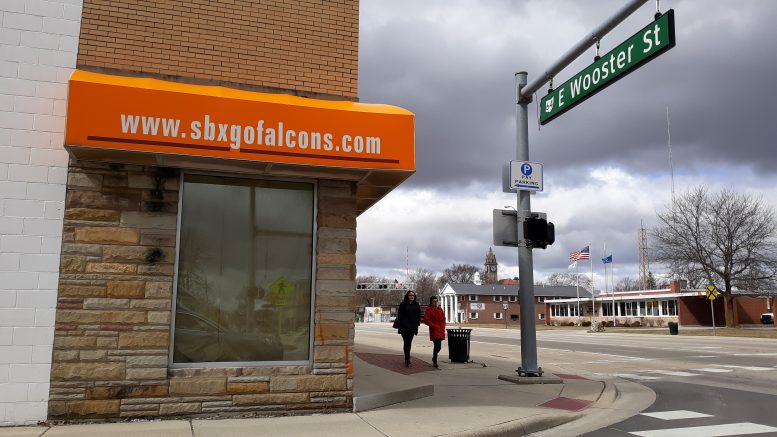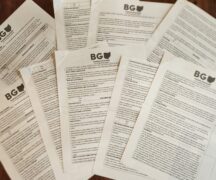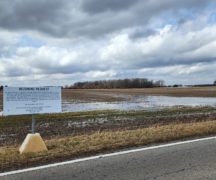By JAN LARSON McLAUGHLIN
BG Independent News
For years, Bowling Green officials have known that the area between BGSU and downtown was less than appealing.
After years of planning, the City Council voted unanimously Monday to establish a Gateway District – in effect, tossing out its tired front door to the city and replacing it with a more welcoming and functional facade.
The action was nothing short of “monumental,” said City Council member Sandy Rowland.
“This is something we wanted for years and years,” Rowland said after the vote.
Over the years, Bowling Green’s well-intended zoning code turned into a barrier to development in the city.
The new zoning category works under a different premise than much of the city’s zoning classifications. Instead of focusing on keeping undesirable land use out, this would focus on attracting desirable uses in.
It will be tried first in the city’s newly named Gateway District – the area along East Wooster Street between the university and the downtown – specifically between Thurstin/Manville and Enterprise streets.
Unlike much of the current zoning, the Gateway zoning discourages single-use buildings – so it would not allow buildings that are completely apartments.
The zoning operates under the premise that people want areas to allow for personality, like more street trees, more bike and pedestrian pathways, more green space, more places that look appealing. They want “street life” that includes outdoor dining on sidewalks, businesses on the first floor like a gym or coffee shop, and residential units above.
Parking garages will be encouraged behind some of the buildings, since paving huge parking lots is a waste of prime real estate. And the city will consider a requirement of bike parking spaces for each building.
A prime Gateway District “opportunity area” is the city-owned property on the northwest corner of East Wooster and Thurstin streets, where the city’s electric division and fire station are currently located. City officials are looking at that area being used to make a statement about the community.
The statement would be made with buildings between three and six stories tall. The first floors of the buildings would be at least 16 feet tall in retail areas. The exteriors would be required to have lots of windows, and use similar building materials of brick, stone, metal, glass or wood. Vinyl siding would be prohibited.
Changes in signage rules are vital, with the Gateway District requiring smaller signs that meet certain standards. Parking garages will be preferred over parking lots, which are considered “dead space” if located in front of buildings.
The Gateway District will promote the development of a higher density, urban neighborhood center along East Wooster Street. It is intended to serve as a gateway and “vibrant connection” between BGSU and downtown Bowling Green.
Characteristics include:
- A mixture of storefront retail, professional offices and dwelling units located in the upper stories or rear of mixed-use buildings.
- Buildings with active building facades set at or close to the sidewalk.
- Pedestrian-oriented scale development with sidewalks wide enough for activity and regularly spaced street trees that promote a walkable environment.
Permitted uses would include:
- Whole building – conference center, hotel, and professional offices.
- Street level/first floor – bar or tavern, barber or beauty shop, child day care center, conference center, day spa, limited commercial, restaurant, retail sales, professional offices and retail services.
- Upper floor – condominiums, efficiency apartments, multiple-family dwellings, university-related residential, conference center, hotel, professional offices.
- Accessory – artisan manufacturing, check-in services for hotel, home occupation, residential amenities, swimming pool, parking lot, parking structure.
Never before has the city had any type of architectural, massing and facade requirements, according to the city’s Planning Director Heather Sayler. Massing is a term in architecture which refers to the perception of the general shape and form as well as size of a building.
The plans call for “interactive bottom floor space with the public sidewalk,” landscaping, buffering and bicycling parking.
“We want this to be a beautiful addition” to the space between campus and downtown, Sayler said.
Vinyl siding will not be allowed.
“We’re really encouraging decorative elements,” she said, explaining the goal is aesthetically pleasing development. That includes “transparency” on the bottom levels, with 70 percent of the street level front of buildings to be glass.
City Council members praised the Gateway District plans.
“This is a very encouraging document,” Council member Greg Robinette said. “I’m looking forward to it. It’s an opportunity to help the community grow.”
“It sounds like a terrific addition to town,” council member John Zanfardino said.
“I share the committee’s optimism,” council President Mark Hollenbaugh said.
“Bowling Green has really done some great planning,” council member Rachel Phipps said, noting the effort has taken a lot of shareholders with “shared vision.”
“I’m super pleased,” Phipps said. It puts into practice all past planning efforts, with a level of detail never before in the city’s zoning code, she said.





